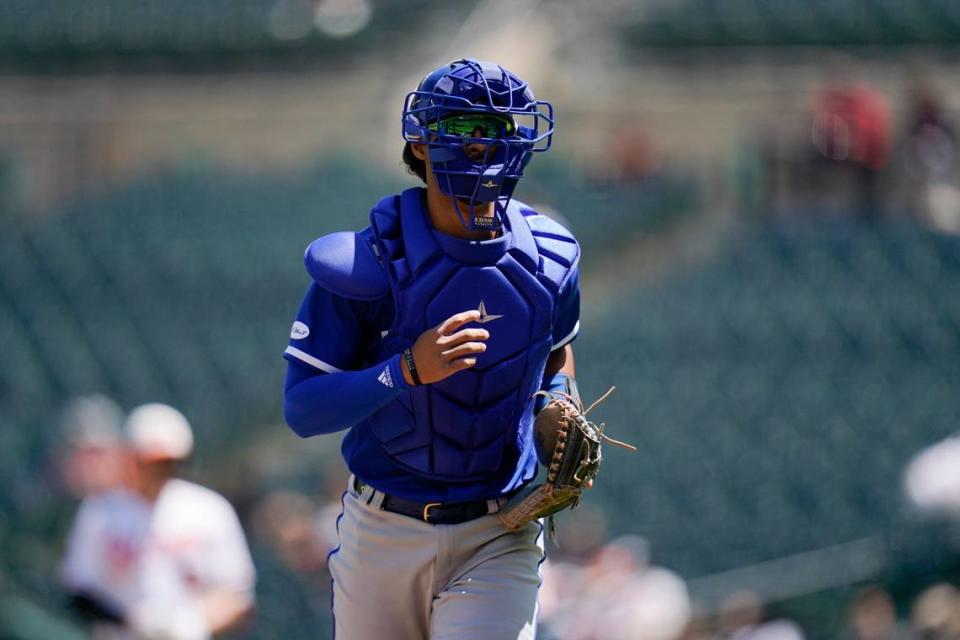Melendez has shown he’s more than just a bat in brief time with the Kansas City Royals
- Oops!Something went wrong.Please try again later.
- Oops!Something went wrong.Please try again later.
- Oops!Something went wrong.Please try again later.
Kansas City Royals rookie catcher MJ Melendez’s prowess in the batter’s box will likely earn him at-bats as a designated hitter, as well as in right field, when the club activates seven-time All-Star catcher and five-time Gold Glove winner Salvador Perez from the injured list.
Melendez homered in Friday night’s loss to the Minnesota Twins, his fourth homer in 20 games in the majors to go along with an OPS of .811.
That doesn’t mean that Melendez’s ability behind the plate will become an afterthought. He’s not simply viewed as a bat by the Royals.
His athleticism allows him to be a viable candidate at other positions, such as right field. But his brief time in the majors (14 starts at catcher) has been about adjusting to the major-league game defensively behind the plate at least as much, if not more, than getting his bat up to speed against top-caliber pitching.
After all, he enters the weekend having taken just 65 at-bats. Meanwhile, he’s been behind the plate for more than 2,000 pitches.
“I think it’s super-important,” Melendez said of his defensive performance. “It’s not just for myself out there. I’ve also got to be out there for the pitcher, do a good job for him. It’s very important. If I mess up, it doesn’t just affect me. It affects the pitcher and, in turn, the rest of the team.”
On Thursday night, Melendez’s ability to block balls in the dirt directly influenced the outcome of the game. The Royals held on for a one-run win against the Minnesota Twins to snap a six-game losing streak.
In a pivotal juncture in the eighth inning with the bases loaded of that win, Melendez blocked no fewer than four balls that bounced in the dirt to prevent a runner from scoring the tying run from third base if the ball got past him and to the backstop.
Royals manager Mike Matheny, a former Gold Glove catcher, lauded Melendez’s crucial blocks and the influence that had on the psyche of pitcher Scott Barlow in that situation.
“MJ did a phenomenal job keeping the ball in front and giving Scott confidence because he has to be able to do that,” Matheny said. “One right after the other, tough blocks. Actually, the first pitch he threw was probably the toughest one. It almost hit the grass while Scott’s just getting a feel for it.”
Barlow turned in one of the most clutch pitching performances of the season for the Royals, entering the game with the bases loaded and getting out of the jam with the one-run lead still intact.
“It does have that carryover effect,” Matheny said. “If he’s having trouble and not blocking them clean, it’s going to take away the confidence of the pitcher to be able to throw that.”
Melendez’s game planning and game calling
Blocking is only one aspect of the job Melendez has been the caretaker of for Perez as the All-Star has been on the injured list with a grade 2 thumb sprain on his catching hand.
There was little question about Melendez’s catch-and-throw ability. His arm strength was evident even before he clocked one of the fastest pop times (1.87 seconds) on a throw to second base by a Royals catcher in the past three seasons. One season in the minors (2019), he threw out 60% of would-be base-stealers.
Melendez won the organization’s Frank White Defensive Player of the Year in 2019, and Baseball America rated him the best defensive catcher in the Royals’ farm system in 2020 and 2021.
The question marks that Melendez has started to answer for the major-league coaching staff include his ability as a receiver and game-caller.
Melendez, 23, admits that the game sped up on him at times early on upon his arrival in the majors. There were a couple rushed throws to second base on stolen bases. A malfunction with a Pitch Comm system led to a passed ball in one game.
Melendez lauded the pitchers on the staff for bearing with him as he experienced that initial learning curve in the middle of big-league games.
While catchers also take part in pregame planning and calling pitches in the minors, the major-league club has a more extensive scouting, video and statistical database that pitchers and catchers dive into in order to prepare for every hitter in a lineup, plus potential bats off the bench.
The expectation from each pitcher is that their catcher thinks along with the pitcher and brings another perspective as well as any personal experience and input he may have into the process.
Earlier this month, Royals starting pitcher Daniel Lynch described Melendez as “a guy that wants to learn and a guy that wants to keep getting better every time out. I appreciate that about him.”
Melendez drew praise from 18-year veteran Zack Greinke, a former Cy Young award-winner, for his game-calling and the way he thought along with Greinke throughout the game.
Specifically, Greinke mentioned Melendez’s willingness to think differently and not necessarily calling pitches strictly by the book.
“We have a little bit more information,” Melendez said of the difference between game planning and calling games in the majors compared to the minors. “There’s a bigger track record to go from. I think that’s really just the biggest difference. At the end of the day, it’s the same game. Hitters are going to adjust at every level. And here, obviously, they make a little bit more adjustments mid-game.”



